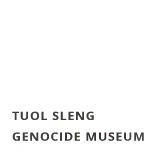Tuol Sleng Genocide Museum is committed to promoting greater understanding of the Khmer Rouge period. The museum aims to encourage the next generation to be united to prevent genocide from happening again in Cambodia and around the world. In order to fulfill its goals, the museum created the Education Team in 2009 and in 2014 greatly expanded its internal programming, external outreach activities, and training and capacity building efforts.
1. Internal Program
These activities are organized on the museum grounds for visitors and include:
White Lotus Room
The Lotus flower is a symbol of peace in Cambodian culture. The White Lotus Room was created in 2015 as a place where visitors could spend time in reflection or meditation to process their emotions after viewing the museum’s exhibitions. The air-conditioned room is designed with comfortable woven mats and cushions, with two performances each day of traditional Cambodian music and Smot chanting.
Activity Room – visit the museum
The Activity Room was created in 2015 for secondary and high school students to gain more knowledge about what happened during the Khmer Rouge regime. Through research and other interactive activities, students are better able to understand the exhibitions at the museum. Additionally, some activities encourage students to interview family members about their lives during the Khmer Rouge period, promoting inter-generational dialogue and understanding. The museum prefers advance notice from schools who are interested in using the Activity Room so that the team can best prepare for the students’ needs.
Testimony Program
First created in 2015, the Testimony program provides a platform for survivors of S-21 to share their stories with the public. In 2016, the museum will expand this focus to include testimonies from as many survivors as can be found, with a focus on testimonies from those who were children during the period. The series is called, Testimonies of the Khmer Rouge Years through The Eyes of Children and Adults.
Activity Guidebook
One of the primary target audiences of the Education team are secondary school students. Noting the lack of information and documents for this age group, the Education team created an activity guidebook for students visiting the museum. The book provides age appropriate information about the museum’s exhibits, as well as educational activities to promote a better understanding about S-21 and the early stages of the creation of the site as the Tuol Sleng Genocide Museum. The initiative was a cooperative effort between Okinawa Art Museum and Okinawa Peace Museum and Tuol Sleng Genocide Museum.
Lectures & Talks
The museum provides two kinds of presentations for visitors.
Student Orientation: These short presentations are designed for organized group visits to the museum. They provide a brief, 20-minute orientation to the museum before visiting the exhibitions. By appointment the Education team can customize talks to target the needs of a wide range of groups. These orientation lectures are very popular with schools, universities, NGOs, government departments, study groups and others. Please contact the museum for more information.
Public Talks: Launched in 2016, this series of talks features local experts on Cambodian history from the French colonial period until the present. The program features a 40-minute presentation followed by 20-minutes of Q&A from the audience. The talks are open to all museum visitors at no extra charge with translation as needed.
Tour guide:
Any organized group of visitors may contact the museum to reserve a tour guide based on the age and interests of the group.
Groups more than 10 people, including school groups, are welcome to contact the Museum for more information about reserving special tour guides, the activity room or the use of other facilities at the Museum. Notifying us in advance about your visit will help us to make your visit truly memorable.
2. Outreach Program:
These programs are organized outside the museum with schools in Phnom Penh. The team’s method stresses interactive learning-by-doing activities that combine research, interviews, presentation and small group work. The aim is to raise awareness among students of the history of the Khmer Rouge period and the importance of preserving the Tuol Sleng Genocide Museum site. Additionally, we hope to encourage students to become messengers of peace for the museum in order to prevent mass atrocities from happening again.
First Week: The Education Team visits the school and presents general information to students about the history of Cambodia.
Second Week: The Education Team returns to the school, now focusing specifically on the Khmer Rouge period and the former S-21 prison. Students are assigned research topics for small group work.
Third Week: Students visit the Museum with instruction from a specialized guide from the Education team. At the Museum, working in their assigned small groups, students undertake an interactive research activity designed by the Education Team.
Fourth Week: The student groups present the results of their research topic to the whole class. Working together, the students are able to better understand the entire picture of before, during and after the Khmer Rouge period.
3. Training:
Committed to strengthening the capacity of its own Education team, Cambodian students and recent graduates, the Museum arranges training programs on a variety of subjects and skills. Some examples include a Capacity Building Workshop for Tour Guides, Proposal Writing, Practical Research Methodologies, and Oral History Collection. In 2016, the museum will provide a series of soft skill training in leadership, management and administration.

